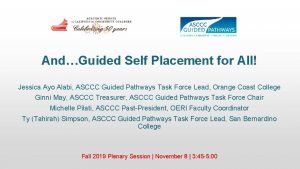THE POWER OF RADIO Ayo Palmer Centre for

- Slides: 1

THE POWER OF RADIO Ayo Palmer, Centre for Innovation Against Malaria, Banjul, The Gambia; Angela Dawson, Liverpool School of Tropical Medicine, UK; Jaye Laskahmi Jaya. Mac Productions Ltd, Northampton, UK, Anna Grey-Johnson Tesito, Banjul, The Gambia; Ya. Ya Kasse, Centre for Innovation Against Malaria, The Gambia; Steve Allen, School of Medicine, University of Swansea, UK; Alieu Sarr, Department of Central Statistics, Banjul, The Gambia; Graham Mytton, PEGS, Kingsway, Howe, UK; Paul Milligan, London School of Hygiene and Tropical Medicine, UK. 1 Radio programmes can be more effective in conveying information about public health if they combine entertainment with education. The use of radio for health promotion in malaria was evaluated in The Gambia through the creation and national broadcasting of the radio soap opera Bolongodala, incorporating public health messages in the storyline. 2 National survey 2000 adults were interviewed. Survey non-response was less than 0. 5%. 97% of respondents were radio listeners. 88% had listened in the week before the survey interview and 53% had listened to the radio the previous day. The radio audience in The Gambia has a broad demographic profile representative of the Gambian population but women listen less often than men (61% of men, and 48% of women, had listened the day before). 22% of respondents had listened to Bolongodala, (24% of men and 20% of women), representing approximately 170, 000 people. The programme’s weekly Reach was 10% of the adult population of The Gambia. 68% of those who had listened to the programme recognized that malaria was the major theme of the series and 41% remembered specific themes about malaria prevention. Bolongodala was more popular among older listeners, and among the Mandinka ethnic group. The reach of the programme was significantly higher among listeners who had no formal education or had attended Koranic school only (25%) than those who had attended primary or secondary school (18%). Listeners prefer programmes in their own language. The reach of the programme could be increased by broadcasting in other languages. A community-based survey was conducted to determine knowledge The 26 -episode series was broadcast attitudes and practice in relation to on national radio twice-weekly in the most malaria. widely spoken local language (Mandinka), Key malaria messages were selected first from July 2003 -February 2004; and in consultation with health staff and then repeated in 2004/5 National Malaria Control Programme. A 30 minute radio phone-in programme A malaria training workshop was held was broadcast following each episode to for script writers. The story is set in a assess audience reaction typical but fictional Gambian village called In one rural community, Julangel, radio Bolonghodala meaning “by the stream”. listening patterns were monitored, 7 radio Malaria themes were plotted across clubs were established to promote episodes. The characters model and discussion of the programmes and to reinforce positive practices to prevent, assist villagers to translate malaria control and manage malaria. messages and recommendations contained in Bolongodala into action; and bed nets were made available at subsidised cost. 3 A national cluster sample survey of media use was conducted during the repeat broadcast to measure the "Reach" of the radio series Bolonghodala, and the use that listeners made of communicated malaria messages. After stratification by Local Government Area, census enumeration areas selected with probability proportional to estimated size, households were selected using random walk and one respondent aged 15+yrs was selected per household. Respondents were asked about radio listening in the previous week. Results 4 In Julangel, a systematic sample of women caring for children <5 yrs old was selected for interview either before or after the series had been broadcast. Nets for children in their care were inspected and a structured questionnaire was used to assess malaria knowledge, health seeking behaviour for a sick child, household use of treated nets and prioritisation of children and pregnant women for the use of treated nets. After the broadcasts focus group discussions about the response to the series were conducted among radio club members. Julangel In Julangel the percentage of children <5 yrs sleeping under a treated or intact net increased from 49% (among 75 women interviewed before the radio broadcasts) to 69% (among 81 women interviewed after the broadcasts. The KAP surveys showed that women were better informed about malaria transmission, treatment and prevention after the broadcasts, with only 5% of women scoring low grades (defined as <60% appropriate responses) on the KAP questionnaires when the responses were scored, compared to 40% with low grades on the same questionnaire among women interviewed before the broadcasts. 5 Conclusion In rural areas radio reaches more people than any other medium. Radio drama can raise awareness of public health issues and can be an effective medium for health promotion. More formal evaluation is needed to assess its impact on malaria prevention.

